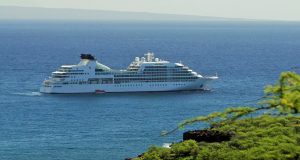Mainstream and Luxury Cruising – An Unlikely Marriage

Photo credit: Seabourn Sojourn in Lanai in the Hawaiian Islands
On June 26, Cruise Industry News reported 73 new 5-star ships will be on the water carrying 1 million guests by 2027. To say this is surprising would be an understatement. Clearly the industry is responding to a demand.
Although it wasn’t the first ever luxury cruise, it might surprise you to know that the first vessel built exclusively for luxury cruising was Prinzessin Victoria Luise of Germany, designed by Albert Ballin, general manager of Hamburg-America Line (aka HAPAG, Hamburg-Amerikanische-Packetfahrt-Actien-Gesellschaft). Designed to look like a private yacht, the ship was completed in 1900 and targeted the wealthy traveler.
There have been many luxury cruise ships since then, with the very earliest offering different classes of service and accommodation. As more ships were launched, a single class of service was adopted and onboard amenities increased, eventually becoming the traditional cruise ships of my youth. The Caribbean was the “hot” destination with basic walking, snorkeling or beach tours; early or late seating for meals; and a flaming baked Alaska as a final farewell at the end of every cruise. It was a successful cookie cutter plan and every cruise line followed the plan. Today’s cruise experience barely resembles those early days.
With ships deployed on all 7 continents, the industry has evolved to appeal to a global demographic by reimagining everything from the onboard experience, to the level of service, to the ports visited. Market segments have been classified into 5 categories; contemporary, premium, luxury, expedition and the niche market. Always on a quest to reinvent themselves, the contemporary brands have entered the luxury market, creating unlikely but very symbiotic partnerships, most recently with Royal Caribbean’s acquisition of Silversea Cruises.
The luxury brands have remained faithful to a winning recipe; smaller is better. Their ships are typically like yachts and carry only 150-300 passengers. The focus is making each guest feel like they’re on a private yacht, with private butler service and exquisite dining experiences. And because the ships are small, they can get into ports that the mega ships can’t. This gives guests an opportunity to explore unspoiled and undiscovered places with authentic experiences without thousands of other cruisers.
The big players in the contemporary market can offer considerable human and capital resources, and that leaves the luxury market poised for healthy and consistent growth. Seems like a match made in heaven.